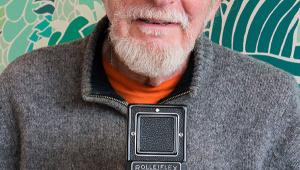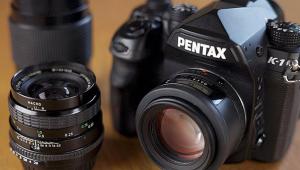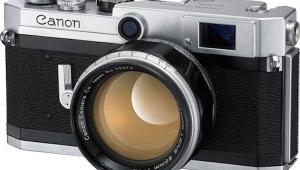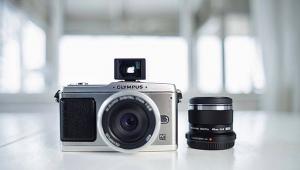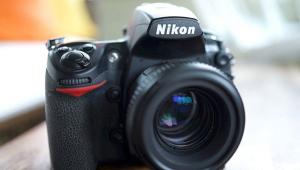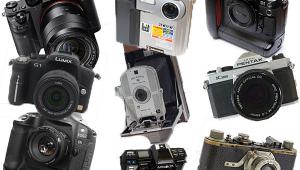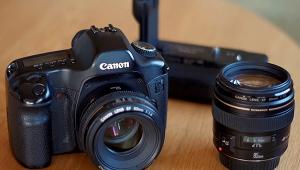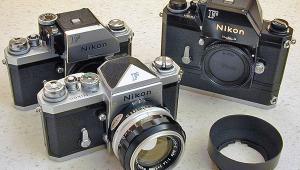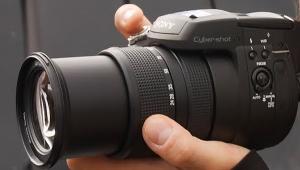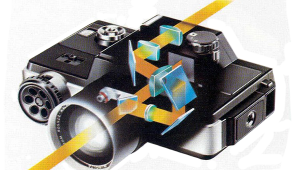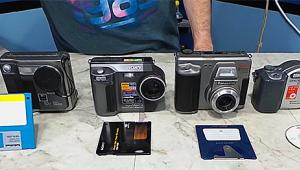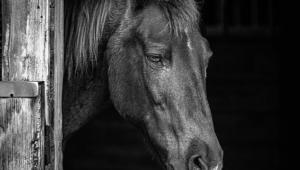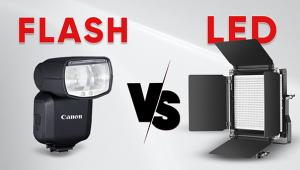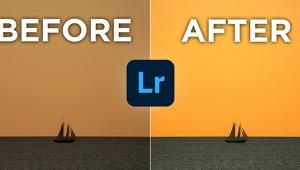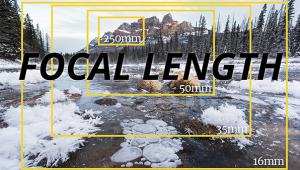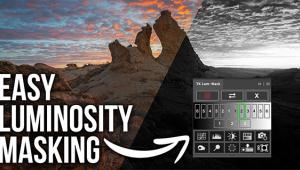glad i stumbled upon your site, it's funny to look back, but also really great, to see how far cameras have come from simple stills to now being used in full , video production . Keep up the good research !
The Mighty Midget: A Unique Rollfilm Camera
When Leitz launched the Leica in 1925, they did more than start the 35mm revolution. They also influenced the way some rollfilm manufacturers began to consider smaller formats. One result was small rollfilm cameras that took their own unique sizes of extra-small film. The Ensign Midget was one of the best.

All Photos © John Wade
Measuring a mere 3.5x1.75x0.75” (9x4x1.5cm) when folded, it was much smaller than a Leica, yet took a picture size of 1.625x1.375” (3x4cm), somewhat bigger than the Leica’s 24x36mm format. It did this on its specially-made Lukos E10 film.
It should be noted that camera production stopped around 1940, but the film was still available for the first half of the 1950s. I have a box of film with an expiration date of August, 1953. My father owned one of the cameras in my collection and I remember him using it when I was a kid on a holiday in the mid-1950s.

I doubt very much if anyone still makes the film today. However, it is the same physical size as 35mm, and it is possible to use it by sticking a piece of 35mm film to backing paper and rolling it yourself. I actually tried this when I was about 16. It works, but the image is larger than a standard 35mm 24x36 image, so the image on the film covers the sprocket holes. Of course, there are no film numbers on the backing paper, but I discovered that one and a half turns of the film wind knob advanced the film about one frame. So, keep in mind that this camera is a collectible, just not a very practical user collectible.

The camera was manufactured by the English company of Houghton-Butcher and sold in the UK by Ensign Ltd., a subsidiary of the main company. It was designed by Swedish engineer Magnus Neill, who was previously famous for designing the Ticka watch-type camera and, more significantly perhaps, the Ensignette, with which it shared some aspects of its design. The Midget came to the market in 1934.
Neill’s intention was to make a camera that folded to a clean design that left no extraneous bulges, bumps, lumps, levers, or knobs. The black rippled body was made from pressed steel with chrome fittings. Gripping two serrated panels top and bottom of the lens panel and pulling forward until the struts click-stopped positively into position extended the depth from 0.75” (1.5cm) to 2.5” (6cm). The Ensign Midget name was emblazoned on each side of the lens in an attractive art deco styling.
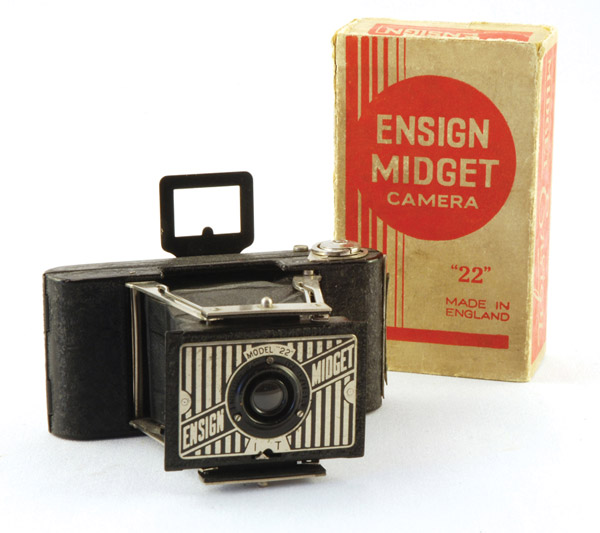
To close the camera, the four struts were held by the thumbs and middle fingers of each hand. As they were pulled out slightly, the index fingers were used to press the lens panel backward, the four struts folding neatly to fit inside the body, top and bottom of the now collapsed lens panel.
The camera was equipped with two viewfinders. The first was a small reflecting brilliant type which, when the camera was held in the vertical position, viewed the subject through an aperture in the lens panel. For horizontal pictures, the same viewfinder folded out from behind the panel on a short arm. For eye-level viewing, a metal frame double-folded onto the top of the lens panel. To erect it, the top half was lifted and then the photographer continued to lift until the second section rose and clicked into position. The fully erected frame then lined up with a sight that swiveled up from the rear of the body.

The shutter, set by a small lever beneath the lens, was speeded 1/25, 1/50, and 1/100 sec, plus “B” and “T.” It was released by a tiny lever behind the lens panel on the opposite side to the foldout viewfinder. A leg to support the camera in its vertical position swiveled down from beside the shutter lever.
Pressing a catch at one end of the body enabled the entire back to be removed and, inside, film loading was made easier by having spools that swung in and out of the body.
All these features were common to two models—initially called the A/D and the A/N—launched at the same time. The differences were in the lenses, apertures, and prices. The A/N was the better of the two, with an Ensar Anastigmat lens that focused from 3 feet to infinity, with five f/stops of f/6.3, f/8, f/11, f/16, and f/22.

Reviewing the camera in 1935, the British Journal Photographic Almanac reported: There can be no doubt that the camera will sell on sight, because of its minimum size and natty appearance. A girl will call it ‘sweet’ and will want to be given one. And the purchaser who knows next to nothing of cameras, yet expects great things from them, will not be disappointed with the results.
In 1935, a new, simplified version was produced. The body of the new camera was much the same as that of the previous models, but the lens panel was redesigned, still with an art deco influence, but with the camera’s name written diagonally across the front. The lens was now fixed focus with a fixed aperture and the only control was by the shutter, which offered “I” and “T” settings. The frame finder was simplified and there was no brilliant viewfinder. Inside, the swing-out film spools of the previous models were dispensed with.

That might have been the complete lineup of Midget models, were it not for the silver jubilee of British monarch King George V and Queen Mary on May 6, 1935. To commemorate the event, two new versions of the Midget were launched, the S33 and the S55. “S” stood for silver. Each camera’s rippled body was painted that color and sold in a smart gray leather slipcase with a lavishly-lined presentation box. The cameras were sold for the same price as their more traditional counterparts.
In 1939, when World War II broke out, Ensign advertised the Midget as A remarkable War-Time Camera. Targeting soldiers, the company claimed: It goes into a tunic pocket with room to spare. It is essentially the camera for the man in camp. Just the thing to give to a fellow who is called up or to a woman in Service.
They also suggested: Some people are making war-time diaries with these Midgets, taking snaps of subjects like children going to school with their gas masks, cars bearing war-time notices, men digging for victory on allotments, or of someone pasting strips of paper on the window. All these little war-time incidents make photographs which will be treasured later on. These cameras are splendid for capturing that sort of thing. It is an idea. Keep an Ensign Midget war-time diary. The photographs will be wonderfully interesting in the years when war is a thing of the past.
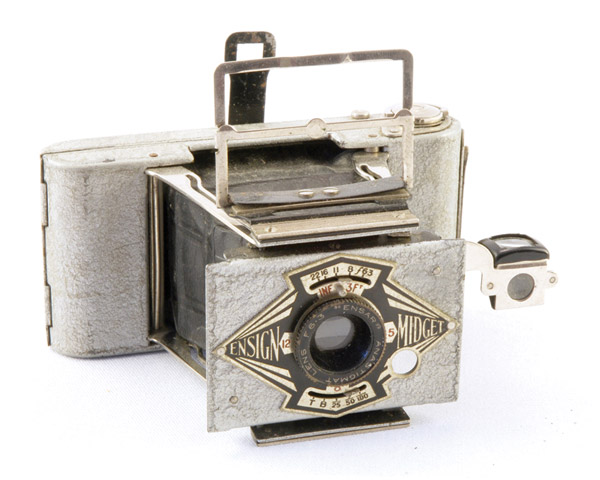
Production of the Ensign Midget halted in 1940 as Houghton-Butcher went over to war work and, on the night of September 24th-25th that year, Ensign’s premises in London were wiped out in a German bombing raid. The camera never resumed production after the war.
Value of Ensign Midgets in good condition today are in the region of $100 for the Model 55, $85 for the Model 33, and $100 for the rarer Model 22. The silver models fetch up to $200, but you can add half to double that if found with the original slipcase and presentation box.
- Log in or register to post comments


With his shaggy, sandy blond hair and a 5-o'clock shadow, Mark Rolston, the creative director for Frog Design, has studied technology for the better part of two decades. As he sees it, smartphones are just about out of evolutionary advances. Sure, form factors and materials might alter as manufacturers grasp for differentiating design, but in terms of innovative leaps, Rolston says, "we're at the end of gross innovation for best smart phone."


